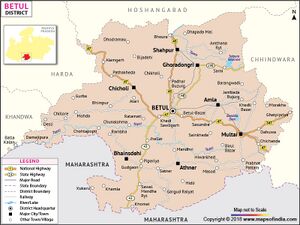Ambadevi Rock Shelter
| Author:Laxman Burdak, IFS (Retd.) |


Ambadevi rock shelters are part of an extensive cave site, where the oldest yet known traces of human life in the central province of the Indian subcontinent were discovered. Named after the nearby ancient Ambadevi Cave Temple, the site has also been referred to as the Satpura-Tapti valley caves and the Gavilgarh-Betul rock shelters. The Ambadevi rock shelters rank among the most important archaeological discoveries of the early 21st Century in India, on par with the 20th Century discovery of the Bhimbetka rock shelters.[1][2]
Variants
- Ambadevi rock shelters
- Satpura-Tapti valley caves
- Gavilgarh-Betul rock shelters
- Ambadevi Cave Temple
Location
The site is located in the Satpura Range of the Gawilgarh Hills in Betul District of the Indian state of Madhya Pradesh, north of Dharul village in Betul district of Madhya Pradesh. [3]
The rock shelters are situated in the Betul District of the Indian state of Madhya Pradesh, around 60 km north of the city of Amravati.[4] in the Vidarbha region, located on the southern slope of the Satpura-Gawilgarh hill ranges, at about 450 m (1,480 ft) above sea level.[5] The site lies 6 km west of the Salbardi pilgrimage destination, near Morshi town, Amravati District.
Discovery
Studies of various rock paintings and petroglyphs present in the caves suggest, that the Ambadevi rock shelters were inhabited by prehistoric human settlers since around 25,000 years ago. First discoveries of clusters of numerous rock shelters and caves were made by Vijay Ingole and his team beginning on 27 January 2007.[6]
The previously unrecorded site was discovered by Vijay Ingole and his colleagues (Padmakar Lad, Manohar Khode, Shirish Kumar Patil, Dnyaneshwar Damahe, and Pradeep Hirurkar) on 27 January 2007.[7][8] Amateur naturalists and bird watchers also explored the area until 2012. More than 100 rock shelters were identified of which at least 30 contain hundreds of pictographs, petroglyphs and stone artifacts. The settlement period of the site ranges from the Upper Paleolithic (25,000 to 15,000 BCE) to the Neolithic (10,000 to 5,000 BCE), the Chalcolithic (after 5,000 BCE) and the Iron Age (1,200 to 600 BCE). Sediment, artefact and stratigraphy studies suggest a continuous sequence of human presence during the entire period.[9]
In 2011, further exploration was undertaken by the Archaeological Survey of India (ASI) under Sahu and her team.[10] More than 225 rock shelters were identified that contained paintings, engravings, and stone tools. Stone tools[11] fashioned out of a cryptocrystalline material like chert, chalcedony, or jasper were discovered in and around several shelters.[12]
Exploration
By 2015 an area of 10 km by 6 km had been explored. The sandstone shelters are covered by lush vegetation and bear a striking resemblance to other rock art sites in India, Australia, South Africa and France.[13][14]
External links
References
- ↑ V. T. Ingole (November 16, 2012). "Distinctive Featuresof the Art of Ambadevi Rock Sheltersin Satpura-Tapti Valley" (PDF). Rock art Society of India Conference. Archived from the original (PDF) on January 28, 2021
- ↑ Mrityunjay Bose (December 19, 2018). "Ostriches once roamed the Indian peninsula". Deccan Herald.
- ↑ Snehlata Shrivastav (April 24, 2014). "Ancient shelters, obscure lives". India Times.
- ↑ Snehlata Shrivastav (April 24, 2014). "Ancient shelters, obscure lives". India Times.
- ↑ "Amba Devi Cave". mapcarta.
- ↑ ngole Vijay, Padmakar Lad, Manohar Khode, Dnyaneswar Damahe, Shirishkumar Patil, and Pradeep Hirurkar: 2007, Discovery of Painted Rock-Shelters from Satpura-Tapti Valley, 153–158, Purakala 17.
- ↑ Ingole Vijay, Padmakar Lad, Manohar Khode, Dnyaneswar Damahe, Shirishkumar Patil, and Pradeep Hirurkar: 2007, Discovery of Painted Rock-Shelters from Satpura-Tapti Valley, 153–158, Purakala 17.
- ↑ V. T. Ingole (November 16, 2012). "Distinctive Featuresof the Art of Ambadevi Rock Sheltersin Satpura-Tapti Valley" (PDF). Rock art Society of India Conference. Archived from the original (PDF) on January 28, 2021.
- ↑ Snehlata Shrivastav (April 24, 2014). "Ancient shelters, obscure lives". India Times.
- ↑ Bhattacharya-Sahu Nandini and Prabash Sahu 2012: Decorated Rock Shelters of Gawilgarh Hills, Madhya Pradesh, Session Paper on International Conference on Rock Art- Understanding Rock Art in Context, IGNCA, New Delhi.
- ↑ Nandini Bhattacharya-Sahu and Prabhash Sahu: 2014, pp 63–78, Artistry in the Rock Shelters of Gawilgarh Hills: Recent Discoveries, Puratattva 44 (Indian Archeological Society, New Delhi), 2014.
- ↑ "Archaeologists discover 12,000-yr-old rock paintings in Betul". Indian Express. February 5, 2013.
- ↑ Prabash Sahu. "Petroglyphs in Recently Discovered Rock Shelters of Gawilgarh Hills". Academia.
- ↑ Prabash Sahu. "Petroglyphs in the Recently Discovered Rock Shelters of Gawilgarh Hills". academia.

